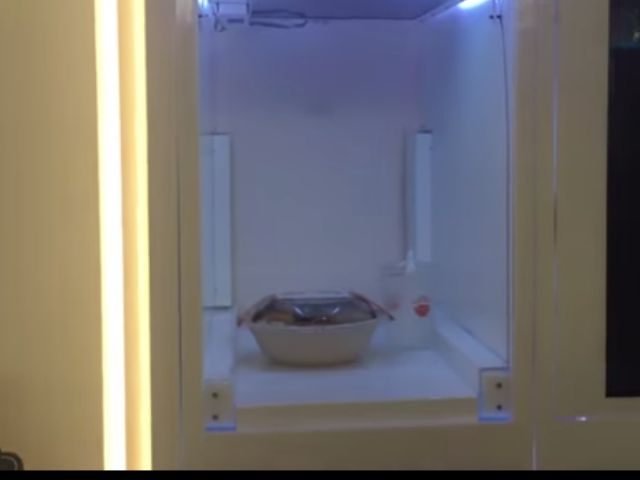(Ferenstein Wire) – I may have just visited the most San Francisco-ish restaurant in the entire history of San Francisco: a tasty fast food quinoa eatery that will operated by robots.
The Ferenstein Wire got a sneak peak at Eatsa, which will be debuting a healthy, fast, hygenic and cheap operation in the downtown area this week, promising customizable menus and — in the near future — a mostly non-human automated experience.
Instead of a front counter, customers use a video kiosk to select and order their quinoa bowls. Then, food pops up in one of a series of translucent cubby holes a few minutes later. It’s difficult to describe all the surreal futuristic style elements that go into the delivery process, so here’s a video below–this restaurant is science fiction come to life.
For now, little of the restaurant is actually automated and the food is prepared by unseen workers. But the owners plan to replace a good portion of their cooking and serving workforce with robots in the next year of two. So, Eatsa functions as a kind of Turing test of a restaurant: there are still a line of chefs working diligently behind the cubby holes, but patrons wouldn’t know if they were human or robotic.
This is a fascinating application of the artificial intelligence test first designed by engineering icon Alan Turing, who said we could claim that a computer had human-like intelligence if a user could not tell whether they were interacting with a humor or robot.
Traditionally, the Turing Test is evaulated on conversation bots, as a panel of judges guess whether they are conversing with a human or an algorithm. In Eatsa’s case, the leadership team of Scott Drummond and Tim Young want to iteratively develop a restaurant design which will look the same when they eventually implemented the automated food preparation and delivery assembly line.
“Our initial prototypes will allow us to test the customer experience and our food, as well as the software system that we’ve developed to tie everything together from ordering through kitchen operations to pick-up,” Drummond tells The Ferenstein Wire.
Perhaps more importantly, Eatsa’s model is one of many technological advancements that is pressuring us to choose between restaurants that provide many low-paid jobs to low-skill workers or restaurants that provide bowls of healthy, hygienic, cheap, no-worry food to wealthy and poor customers.
Eatsa’s food is tasty and cheap. The company promises a bowl full of nutrients that outmatches many of their less healthy competitors. A $6 meal is virtually unheard of in San Francisco outside of McDonalds. The bowl I enjoyed tasted like it could have come from a pricey restaurant or one of the city’s uber-expensive upscale grocers.
Drummond tells me he’s able to get these low prices through a series of technological efficiencies that bring down the cost of made-to-order food. “Technology plays an important role in improving the speed, convenience and efficiency of our experience. By making things as efficient as possible, we can offer a great price now for a high quality product,” he explains.
Eventually, the automation of the kitchen could allow Eatsa to bring healthy meals to neighborhoods all around the city. Anywhere there’s a McDonald’s, Eatsa’s healthy food is competitive, thanks in part to automation. This is a huge win for nutrition-deprived neighborhoods all over the country.
Drummond and his colleagues artfully dodge my questions about government and economic pressure on the food industry. Since a new $15 minimum wage law passed, the tradeoff between wages and employment has become a hot button issue in San Francisco; Some restaurants claim that the new minimum wage has forced them to shutter their doors.
Many low-skill restaurant workers — including many foreign workers who were imported by cost-cutting companies — are demanding better pay, spurring the economic incentive for companies to automate their human labor out of existence.
Up to now, this has been futuristic speculation, but now it’s something San Francisco will have to grapple with very soon. It is clear that Silicon Valley’s technology is making it increasingly difficult for government regulators to pin the social and economic costs of automation on free-market businesses.
But Eatsa’s counter-pitch is compelling: they’re offering to use automation to bring tasty, healthy and affordable food to the masses that are increasingly being sidelined by automation. Their impressive execution makes a persuasive case that they’ll succeed.
For more stories like this, subscribe to the Ferenstein Wire newsletter here.

COMMENTS
Please let us know if you're having issues with commenting.